No.257 - "ニーベルングの指環" 入門(1)序論・自然 [EX.1-38] [音楽]
2019.4.26
Last update : 2024.4.17
Last update : 2024.4.17
No.14-15「ニーベルングの指環(1)(2)」で、リヒャルト・ワーグナーのオペラ(楽劇)『ニーベルングの指環』で使われているライトモティーフ(示導動機)について書きました。この長大なオペラにおいてドラマを進行させるのは、登場人物の歌唱と演技、舞台装置、オーケストラの演奏だけではなく、それに加えてライトモティーフです。つまり、ライトモティーフだけでドラマの今後の進行を予告したり、ライトモティーフだけで歌唱と演技の裏に隠された真の意味を説明するようなことが多々あります。従って『ニーベルングの指環』を真に "味わう" ためには、ライトモティーフを知ることが必須になってきます。
もちろん No.14-15 で書いたのはライトモティーフのごくごく一部です。ライトモティーフの全貌を知るにはどうすればよいか。一番参考になるのは、ショルティ指揮・ウィーンフィルハーモニー管弦楽団の『ニーベルングの指環』全集(輸入盤・日本盤)に付けられた英国の音楽学者、デリック・クック(1919-1978)によるライトモティーフ解説でしょう。特に、日本盤CD(POCL9943-9956。14枚組)には日本語音声による解説CD(DCI-1043-1045。3枚組)が付録としてついていたので、この全集を入手できる人はそれを聴くのが一番です。
日本語の解説CDがついた全集を入手できない場合は、そのライトモティーフ解説だけを独立させて販売されている2枚組CD(英語版)があります。
An Introduction to Der Ring Des Nibelungen("ニーベルングの指環" 入門)
です。これは現在でも通販などで入手できます。また、デリック・クックの英語解説の音声データは、YouTube で Part1~3 の3つに分けて公開されています(2019.4.26 現在)。タイトルは、
です。つまり、英語解説なら容易に入手、ないしは試聴することができるわけです。そこで以下は 2枚組CD(英語版)を基準に話を進めます。
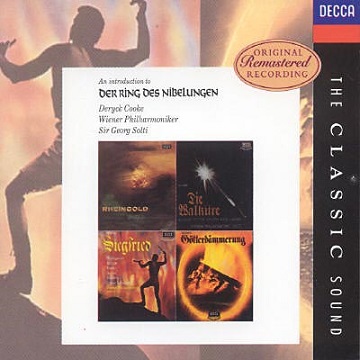
| ||
|
An Introduction to Der Ring Des Nibelungen
2枚組CDで、合計約140分のコンテンツである。イギリスの音楽学者、デリック・クックがライトモティーフの解説を行い、ショルティの「ニーベルングの指環全集」の音源が続く。それが221回、繰り返される。音楽の録音は1958年~1965年で、解説の録音は1967年。 | ||
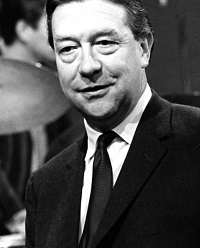
| |||
|
Deryck Cooke
(1919-1976) デリック・クックはマーラーの交響曲第10番を補筆・完成させたことで有名。今日CDで発売されているマーラー第10番のほとんどはクック版である。 (site : www.bbc.co.uk)
| |||
ライトモティーフの解説だけで2時間20分、というのも相当なものですが、『指環』を続けて演奏したとすると15時間程度にはなるので、それと比べると大したことはないとも言える。
大したことはないが、それでも2時間20分です。『指環』の迷宮構造を理解するつもりで聴き始めたとしても、この2時間20分だけでライトモティーフの迷宮にさまよい込んだ気持ちになる可能性が大です。『指環』に "のめり込む" には、そこを突破する根気としつこさが必要なのです。
とりあえず、2時間20分はよしとしましょう。しかし大きな問題は英語です。つまり、デリック・クックの英語による解説のリスニングに集中する必要があり、これは非常に疲れます。英語が得意という人を除いて、おそらく大多数の人はそうだと思います。しかもライトモティーフの迷宮をさまよいつつのリスニングであり、疲れ倍増です。解説と演奏が交互にあるので、本来なら主役であるワーグナーの音楽を聴く方により集中したいのですが、どうしてもリスニングに集中せざるを得ず、音楽は頭を休める休憩時間になってしまう。これでは本末転倒です。
さらに問題は、デリック・クックの英語による解説文がCDのブックレットに載っていないことです。つまり解説内容を(英和辞典などで)確かめる手段がありません(あまり使わないような単語もキーワードとして出てきます)。オリジナルの LP版『指環 全集』には解説書があったようなのですが、2枚組CD のような小さなパッケージにぶ厚いブックレットをつけるのは、どだい無理ということでしょう。
そこで、これから『指環』に "のめり込みたい" という殊勝な人のために、デリック・クックの英語解説の対訳(試訳)とライトモティーフの譜例(これは CD のブックレットに載っています)を掲載したいと思います。CD(ないしは英語音源)を聴くときの、あるいは CD を持ってはいるがリスニングが苦手な人の参考になると思います。いわば "デジタル版 対訳付き ブックレット" です。
訳語、記号など
まず、対訳に当たってのいくつかの訳語や記述方法を書いておきます。
| motive: モティーフ |
デリック・クックの解説では、ライトモティーフ(独:leitmotiv、英:leading motive もしくは leitmotif。leitmotive と言うこともある)のことを単に "motive" と呼んでいます。従って日本語訳も "モティーフ" としました。
もちろん、ライトモティーフを識別して名前を付けるやり方は解説者によってまちまちです。特に、デリック・クックの流儀は一般的なものと相違する面があります。またすべてのライトモティーフを解説したのでもありません。しかしそういう些細なところは抜きにして、この CD が目指している、真に重要なライトモティーフとその変遷をたどり『指環』の構成原理を知ることに集中すればよいと思います。その構成原理をたどる中から、『指環』4部作という長大な楽劇のテーマが自然と浮かび上がってきます。
| 記号など |
《》はモティーフ名、『』は楽劇の名称、何も無いのは人物名などの名詞です。たとえば、
| 《 | ジークフリートのモティーフ | ||
| 『 | 楽劇 "ジークフリート" | ||
| 登場人物名 |
です。また、すでに使っていますが『指環』=『ニーベルングの指環』です。なおドイツ語表記におけるウムラウトは単に省略しました(Walkure, Brunnhilde, Gotterdammerung などと表記)。
| definitive form: 確定形 |
『指環』の1つのライトモティーフは変形されて別の形になったり、またモティーフがその断片から次第に形づくられるといったことがあります。これらの中で、最もはっきりした形で、オペラの中で繰り返し現れる形が "definitive form" です。
いわばモティーフが完成した姿なので、"完成形" あるいは "完全形" とすることも考えられますが、ここでは "確定形" としました。完成とか完全とすると「そこで終わり」のようなイメージですが、そこからまた変遷を繰り返すといったことが多々あります。
| embryonic form: 萌芽形 |
embryonic とはあまり聞かない言葉ですが、動植物の発生の初期段階の "胚" を意味する英語、embryo の形容詞形です。つまりモティーフが確定形になる前の、発生段階の形を言っています。原始形とか原形といった訳も考えられますが、embryonic のもともとの意味を尊重して "萌芽形" としました。
| tansformation: 変形 |
一つのモティーフは形を変えて、隣接した意味の(あるいは正反対の意味の)モティーフになります。このことをデリック・クックは tansformation と言っています。変形、変換、変質、転換というような意味ですが、"変形" としました。音楽なので変奏としたいところですが、通常言われる変奏とは少々意味が違います。
A → B とモティーフが変形されるとき、B からみた A が original form です。「原形」「元々の形」などとしました。またこの変形の途中で中間的な形があるとき、つまり A → C → B となるとき、A → B の変形からみた C が intermediate form です。"中間形" としました。
デリック・クックは、こういった変形のプロセスを重要視してモティーフに名前をつけています。たとえば『指環』の冒頭のホルンの上昇和音は、普通は《自然の生成》、ないしは《生成》と呼ばれ、そのあとに出てくる弦楽器のうねるようなモティーフが《自然》と呼ばれています。しかしデリック・クックの表現では、前者が《自然》の原形(original form)で、後者が《自然》の確定形(definitive form)です。
| family / basic motive: ファミリー / 基本モティーフ |
変形のプロセスで作り出されたモティーフの一団が family です。訳すとしたら「族」「一族」などでしょうが、何となくそぐわないのでそのまま "ファミリー" としました。ファミリーを作り出す出発点となるモティーフが basic motive =基本モティーフです。これは確定形のこともあり、そうでないこともあります。
| segment: セグメント |
モティーフの1部分を言います。たとえば上昇し下降するモティーフがあったとき、上昇部分が第1セグメント、下降部分が第2セグメントなどと使います。"部分" とか "断片" というのもピッタリしないので、そのまま "セグメント" としました。もちろんセグメントは2つとは限りません。《ヴァルハラ》のモティーフなどは4つのセグメントから成っています。
| arppegio: アルペジオ |
和音を同時に鳴らすのではなく数個の音に分けて鳴らすのを「分散和音」、分散和音の中で上昇(ないしは下降)するものを「アルペジオ」と定義すると、デリック・クックは後者の意味で arppegio を使っているようです。そのまま「アルペジオ」としました。たとえば『指環』の冒頭の上昇するホルンの分散和音がアルペジオの例です。
| special illustration: 特別の例示 |
演奏のほとんどはショルティ版『指環』の音源の一部を切り取ったものですが、中にはこの CD のために特別に演奏したものもあります。音を伸ばして和音として響かせるとか、あえてゆっくり演奏するとかの、ワーグナーのスコアどおりではない演奏です。これをデリック・クックは special illustration と言っています。ここでの illustration は「例をあげて説明する、例証する」ことの意味なので "特別の例示" とか "ここだけの例示" としました。
| EX番号 |
デリック・クックはライトモティーフに通し番号をつけていて、EX.nnn と表記されます。2枚組の CD では合計193個のライトモティーフがあり、ブックレットにその楽譜が記載されています。ただし重複して出てくるものがあるので、ライトモティーフは延べ 221 回出てきます。2枚組 CD は、
| CD1: | EX.1 | ~ | EX.103 |
| CD2: | EX.104 | ~ | EX.193 |
という構成です。YouTube に公開されている3部構成の音声データでは、
| Part 1: | EX.1 | ~ | EX.78 |
| Part 2: | EX.79 | ~ | EX.167 |
| Part 3: | EX.168 | ~ | EX.193 |
です(2019.4.26 現在)。また以下の対訳は「"ニーベルングの指環" 入門」(1)~(5)の5回に分ける予定なので、
| (1): | EX.1 | ~ | EX.38 |
| (2): | EX.39 | ~ | EX.79 |
| (3): | EX.80 | ~ | EX.114 |
| (4): | EX.115 | ~ | EX.161 |
| (5): | EX.162 | ~ | EX.193 |
となります。
|
CD1-Track01
Of all great musical compositions, Der Ring des Niebelungen is by far the largest. A consecutive performance of its four separate parts would last for some 15 hours. To confer unity on this vast scheme, Wagner built his score out of a number of recurrent themes, each one associated with some element in the drama and developed in conjunction with that element throughout the work.
すべての偉大な音楽作品の中でも『ニーベルングの指環』は突出して大規模なものです。4部作を連続して演奏するとしたら15時間程度はかかるでしょう。この巨大な体系に統一感を与えるため、ワーグナーは何度も現れる一連の旋律を用いてスコアを構築しました。それぞれの旋律はドラマの何らかの要素と関連づけられ、要素と結びつきながら作品全体の中で発展していきます。
These themes or Leading Motives, as they've come to be called, are not mere identification tags, nor is the score a simple patchwork made up by introducing each motive at the appropriate point in the stage action. Wagner's own description of his themes was "melodic moments of feeling". And writing about his intentions beforehand, he said these melodic moments will be made by the orchestra into a kind of emotional guide throughout the labyrinthine structure of the drama. Wagner's motives have in reality a fundamentally psychological significance, and his score is a continuous symphonic development of them, reflecting the continuous psychological development of the stage action.
このような旋律を "示導動機" と呼ぶようになりましたが、この動機(モティーフ)は単なる識別用の印ではありません。また、舞台演技の適切な時点にそれぞれモティーフを割り当てて単純なパッチワークのスコアを作ったのでもありません。ワーグナー自身によると、これらの旋律は感情の旋律的な表現です。そして彼はその意図について、オーケストラによるこれらの旋律的表現がドラマの迷宮構造の情緒的なガイドになるだろう、とも書き記しています。事実、ワーグナーのモティーフは基本的に心理的な意味を持っています。そしてスコアは、モティーフを絶えずシンフォニックに発展させて作られています。それは、舞台演技が絶えず心理的に発展することを反映しています。
In consequence, a comprehensive analysis of The Ring would be an enormous task. It would involve clarifying the psychological implications of all the motives and tracing their changing significance throughout the whole of the long and complex development. Nevertheless, understanding and enjoyment of the work can be greatly helped by simply establishing the identity of all the really important motives, and indicating what immediate dramatic symbols that stand for, which is all of this introduction is intended to do.
The motives are associated with four different types of dramatic symbol : characters, objects, events and emotions. An example of a motive representing a character is the stern fanfare which introduces Hunding in Act 1 of Die Walkure.
その結果、『指環』の全体像を分析するとなると膨大な仕事になります。そのためには、全てのモティーフの心理的な含意を明らかにし、長大で複雑な進行においてその意味がどう変わっていくかを追跡することになるでしょう。しかしながら、真に重要なモティーフだけを識別し、それが直接的に示しているドラマのシンボルを指摘するだけでも、この作品を理解し味わうための大きな助けとなります。この "手引き" が意図したすべてがそれです。
モティーフは4つの異なったタイプのドラマのシンボルと関連づけられています。人物、モノ、出来事、そして感情です。人物を表現するモティーフの例は『ワルキューレ』の第1幕において《フンディング》を表す厳粛なファンファーレです(訳注:第2場 冒頭)
モティーフは4つの異なったタイプのドラマのシンボルと関連づけられています。人物、モノ、出来事、そして感情です。人物を表現するモティーフの例は『ワルキューレ』の第1幕において《フンディング》を表す厳粛なファンファーレです(訳注:第2場 冒頭)
| EX.1: 《フンディング》 |
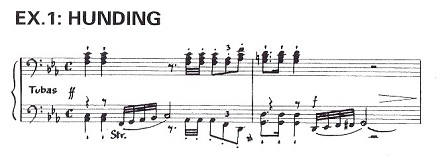
An example of a motive representing an object is the genial theme associated with Freia's Golden Apples. This is introduced in Scene 2 of Das Rheingold. It's sung by Fafner as he explains the value of the Apples to Fasolt.
モノを表すモティーフの例は、フライアの《金の林檎》に関連づけられた優雅な旋律です。これは『ラインの黄金』の第2場で導入され、ファフナーがファゾルトに林檎の価値を説明するときに歌います。
| EX.2: 《金の林檎》 |

An example of a motive representing an event is the brief agitated figure on the woodwind which follows Alberich's Threat of violence against the Rhinemaidens in Scene 1 of Rheingold.
出来事を表すモティーフの例は『ラインの黄金』の第1場においてアルベリヒがラインの乙女を暴力で《威嚇》する時に木管楽器で演奏される、短い切迫した音符です。
| EX.3: 《アルベリヒの威嚇》 |

An example of a motive representing an emotion is the furious repeated figure on the orchestra which portrays Siegfried's Anger during Act 1 of Siegfried.
感情を表すモティーフの例は『ジークフリート』の第1幕においてオーケストラが激しく繰り返す音符で、《ジークフリートの怒り》を描写しています(訳注:第1場)。
| EX.4: 《ジークフリートの怒り》 |

These examples are only four of the almost innumerable motives in The Ring. But at the heart of this diversity there is a simple unity, practically all the motives arise from a few basic motives. Each of these basic motives represents one of the central symbols of the drama, and it generates a number of other motives by a process of Transformation to represent various aspects of the central symbol concerned.
And so we can thread our way through the jungle of motives in The Ring by grouping them into their different families. We can start from each basic motive in turn and trace the family of motives it generates throughout The Ring before continuing with the next basic motive.
これらの例は『指環』のほとんど数え切れないモティーフの、ほんの4つの例に過ぎません。しかしモティーフの多様性の根幹のところには、ある単純な統一性があります。つまり、実質的に全てのモティーフが数個の基本モティーフから生起していることです。基本モティーフのそれぞれはドラマの中心的シンボルの一つを表し、変形のプロセスで他の数多くのモティーフを作り出します。それによりモティーフに関連づけられた中心的シンボルのさまざまな側面を表すのです。
従って、モティーフを異なったファミリーに分類することで『指環』の "モティーフのジャングル" に分け入ることができます。そこで、一つの基本モティーフから出発し、そこから作られるファミリーを『指環』の全体を通して追跡することにします。それが終われば、次の基本モティーフというように繰り返します。
従って、モティーフを異なったファミリーに分類することで『指環』の "モティーフのジャングル" に分け入ることができます。そこで、一つの基本モティーフから出発し、そこから作られるファミリーを『指環』の全体を通して追跡することにします。それが終われば、次の基本モティーフというように繰り返します。
CD1-Track02
The fundamental symbol in The Ring is the World of Nature, from which everything arises, into which everything returns. And Wagner's basic motives for this ultimate source of existence is that fundamental element in music, the major chord. This chord, spread out melodically as a rising major arpeggio by the horns, forms the mysterious Nature motive which opens the whole work.
『指環』における最も基礎的なシンボルは "自然界" です。全てがそこから生まれ、全てがそこに帰っていく。そしてワーグナーは、この究極の "存在の根源" の基本モティーフとして、音楽の基本要素である長和音を当てました。この和音はホルンによる長調の上昇アルぺジオのメロディーとして広がり、神秘的な《自然》のモティーフを形作ります。これが作品全体の開始です(引用注:EX.5/6/7 は『ラインの黄金』のオーケストラ前奏曲)。
| EX.5: 《自然》のモティーフ(原形) |

This is the Original Form of the Nature motive. It soon undergoes a simple melodic transformation into a peacefully undulating string theme, and the result is what may be called the Definitive Form of the Nature motive, since this is the form in which it will recur throughout the whole work.
これが《自然》のモティーフの原形です。すぐにこれはシンプルなメロディーの変形が加えられ、穏やかにうねる弦の旋律になります。これが《自然》のモティーフの確定形と呼べるでしょう。なぜなら、この形が作品全体で再現するからです。
| EX.6: 《自然》のモティーフ(確定形) |

The next transformation is that this definitive form of the Nature motive simply begins to move at twice the speed and in so doing it comes a new motive, the surging motive of the River Rhine.
《自然》の確定形の次の変形は、シンプルに2倍の速さへの移行で始まります。こうすることで新しいモティーフになります。波打つような《ライン河》のモティーフです。
| EX.7: 《ライン河》 |

Tracing further the family of motive generated by the basic Nature motive, we must pass on now to Scene 4 of Rheingold for the next transformation, Here the Nature motive by turning from major to minor, and from a flowing 6/8 to a slow 4/4 time, becomes the dark motive of Erda, the Earth Goddess.
《自然》の基本モティーフから生成されるファミリーをさらに追っていくと、『ラインの黄金』の第4場まで行って次の変形が出てきます。ここで《自然》のモティーフは長調から短調に変わり、また流れるような8分の6拍子からゆっくりとした4分の4拍子に変わって、大地の女神《エルダ》の暗いモティーフになります。
| EX.8: 《エルダ》 |

So far the transformations of the Nature motive have been simple ones, but the next is more radical. The motive turns upside down implying its own opposite. When Erda begins to warn Wotan of the end in store for the Gods, the orchestra accompanies her with her own motive, itself a simple transformation of the Nature motive as we have heard.
But as she comes to the point, the orchestra changes her rising motive into a falling one. The motive of life and growth becomes the motive of decay and death. Here's the whole passage. The orchestra has two statements of Erda's rising motive followed by its inversion, the falling motive of the Twilight of the Gods.
ここまでの《自然》の変形はシンプルなものでしたが、次はもっと大胆です。モティーフは上昇が下降になって反対の意味を暗示します。エルダが神々に降りかかる終末をヴォータンに警告するとき、オーケストラは彼女のモティーフを伴奏しますが、それ自身は今まで聴いた《自然》のシンプルな変形です。
しかし肝心な所にくると、オーケストラは上昇するモティーフを下降するモティーフに変えてしまいます。生命と成長のモティーフが、衰退と死のモティーフになるのです。次がそのパッセージで、オーケストラは2つを提示しています。上昇するエルダのモティーフと、それに続く反転形、下降する《神々の黄昏》のモティーフです。
しかし肝心な所にくると、オーケストラは上昇するモティーフを下降するモティーフに変えてしまいます。生命と成長のモティーフが、衰退と死のモティーフになるのです。次がそのパッセージで、オーケストラは2つを提示しています。上昇するエルダのモティーフと、それに続く反転形、下降する《神々の黄昏》のモティーフです。
| EX.9: 《エルダ》 / 《神々の黄昏》 |
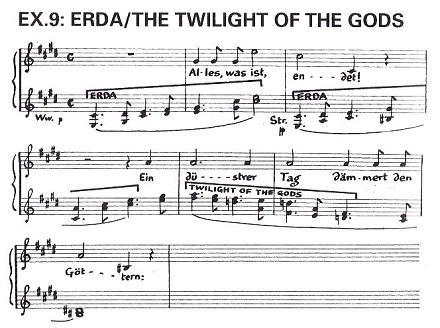
The strings accompany Erda's voice very softly here, only hinting the Gods' mortality. We can hear what happens more clearly if we have the acompaniment played the orchestra alone. First the rising Erda motive and then immediately its inversion, the falling motive of the Twilight of the Gods.
ここでエルダの歌唱を伴奏する弦楽器は非常にやさしく、神々が死ぬ運命であることを暗示しています。オーケストラの伴奏だけを取り出して聴くと、何か起こっているかがもっと明確に聴き取れます。最初に上昇する《エルダ》のモティーフ、すぐに続くのがその反転形、下降する《神々の黄昏》のモティーフです。
| EX.10: 《エルダ》 / 《神々の黄昏》 |
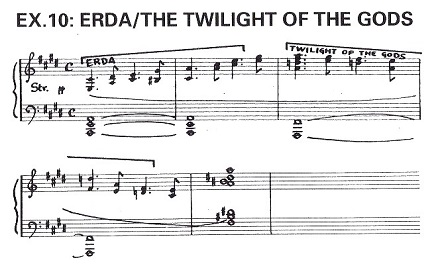
This mysterious falling, fading motive, like so many of the others, recurs at many points in The Ring. Naturally, it permeates the final part of the work, The Twilight of the Gods or Gotterdammerung. And inevitably it introduces the final scene when Brunnhilde steps forward to perform the decisive actions that bring about the end of the Gods.
この神秘的で、下降して消えるモティーフは、他のモティーフと同様に『指環』の多くのところで再現します。当然、最後の作品である『神々の黄昏』にも出現します。そして最終場面、ブリュンヒルデが神々の終末をもたらす決定的な行動をとる場面は、必然的にこのモティーフで始まります(引用注:第3幕 第3場)。
| EX.11: 『神々の黄昏』の 《神々の黄昏》 |

CD1-Track03
Returning now to the Nature motive and its further transformations. After Erda on her warning in Rheingold, we have to wait until Act 1 of Siegfried for the next transformation, another simple one. This occurs when Wotan speaks to Mime of the all powerful Spear that he cut from the World's Great Ash Tree, the Tree of Life, guarded by Erda's daughters, the Norns. The orchestra acompanies his words with a new rhythmic variant of the Nature motive in the minor and in 3/4 time. Here first, the reminder is the Nature motive again.
《自然》のモティーフとその変形に戻りましょう。『ラインの黄金』においてエルダが警告を発したあと、次の変形は『ジークフリート』の第1幕まで待たねばなりません。それはもう一つのシンプルな変形で、ヴォータンがミーメに槍について話すときに出てきます。この槍は、エルダの娘であるノルンたちが守っている生命の木、世界のトネリコの樹から切り出したもので、万能の力を持っています。ヴォータンが話すとき、オーケストラは《自然》の新しい変奏、短調で4分の3拍子の変奏で伴奏します。まずリマインドのために、もう一度《自然》のモティーフです。
| 《自然》のモティーフ(確定形): EX.6 |

And here's the swaying motive of the World Ash Tree as it's introduced to accompany Wotan in Act 1 of Siegfried. Listen to the orchestra.
そして『ジークフリート』の第1幕でヴォータンの伴奏に導入される揺れ動くモティーフ、《世界のトネリコの樹》が次です(訳注:第2場)。オーケストラのところを聴いてください。
| EX.12: 《世界のトネリコの樹》 |
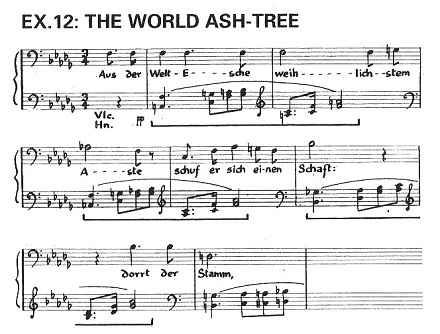
This World Ash motive, which has a close kinship with Erda's motive, recurs in The Twilight of the Gods in conjunction with Wotan's cutting down of the Tree of Life to provide fuel to burn Valhalla. It permeates the scene of the Norns, Erda's daughters, who are bewilded by this fatal act of Wotan's.
この《世界のトネリコの樹》のモティーフは《エルダ》のモティーフと血縁関係にあり、『神々の黄昏』においては、ヴォータンがヴァルハラを焼く燃料にするために生命の樹を切り倒すことに関連して再現します。エルダの娘たちであるノルンが、ヴォータンの致命的行為に当惑するシーンに出現します。
| EX.13は『神々の黄昏』の序幕でオーケストラ前奏が終わった直後に入ってくるノルンたちの歌唱のところ。 |
| EX.13: 『神々の黄昏』の 《世界のトネリコの樹》 |
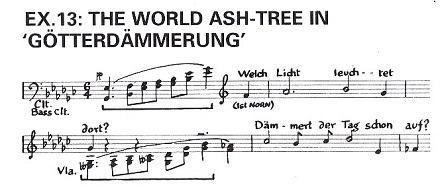
After the introduction of this World Ash motive in Act 1 of Siegfried, the next transformation of the Nature motive ocurs in the Second Act, where Siegfried is in the forest. Wagner takes a very slow, dark, minor version of it, akin to Erda's motive, and he superimposes on this slowly oscillating string figuration. The result is what may be called the Embryonic version of the motive of the Forest Murmurs.
『ジークフリート』第1幕で《世界のトネリコの樹》が導入されたあとで、次の《自然》のモティーフの変形は第2幕に出てきます(訳注:第2場)。ここでジークフリートは森にいます。ワーグナーは《エルダ》に似た、非常にゆっくりとした暗い短調のモティーフを採用し、そこにゆっくりと揺れ動く弦の音符を重ねています。その結果は《森の囁き》のモティーフの萌芽形と呼べるものになります。
| EX.14: 《森の囁き》 萌芽形 |
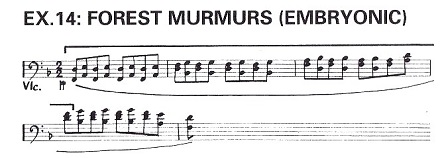
This embryonic version of the Forest Murmurs motive soon begins developing the oscillating figure freely without regard to the original Nature motive basis.
この《森の囁き》の萌芽形は、すぐに揺れ動く音形に発展します。オリジナルの《自然》を離れた自由な展開です。
| EX.15: 《森の囁き》 中間形 |

Out of this development by a process of increasing the speed of the oscillation in 6/8 time, Wagner eventually evolves the definitive shimmering major form of the Forest Murmurs motive, the one that has to be used entirely from here onward.
ワーグナーはこの展開を進め、8分の6拍子にして動きの速度を上げることで、長調の煌めくような《森の囁き》の確定形へと徐々に進化させます。これ以降は、すべてこの形が使われます。
| デリック・クックは8分の6拍子と言っているが、EX.16の譜例でも明らかなように、8分の9拍子が正しい。 |
| EX.16: 《森の囁き》 確定形 |

CD1-Track04
A number of further motives in the Nature family are evolved not from the definitive form of the Nature motive with which we've been concerned so far, but from its original form, the rising major arpeggio on the horns which opens The Ring and with which we started. These further motives are free transformations of the original Nature motive in that they themselves are forms of the rising major arpeggio. First, a reminder of the original Nature motive.
《自然》のファミリーに属するモティーフは、これまで見てきた《自然》の確定形から進化したものばかりではなく、《自然》の原形から進化したものもあります。つまり、この解説をスタートした『指環』の開始を告げるホルンの長調の上昇アルペジオから進化したものです。それらのモティーフは《自然》の原形の自由な変形であり、それ自体が長調の上昇アルペジオになっています。まず、リマインドのために《自然》のモティーフの原形です。
| 《自然》のモティーフの原形: EX.5 |

The first free transformation of this original Nature motive is the important motive of the Gold which is introduced by the horns in Scene 1 of Rheingold.
《自然》の原形の自由な変形の最初は、《黄金》という重要なモティーフです。『ラインの黄金』の第1場でホルンによって示されます。
| EX.17: 《黄金》 |
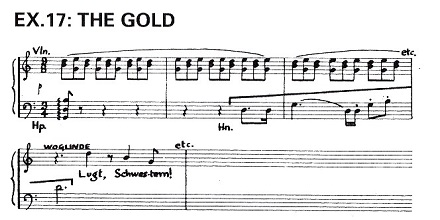
The next free translation of the original Nature motive is the bold motive of Donner. He himself sings this as he calls up the storm in Scene 4 of Rheingold and he's echoed by the horns.
《自然》の原形の自由な変形の次は、力強い《ドンナー》のモティーフです。『ラインの黄金』の第4場においてドンナーが嵐を呼ぶときに彼自身が歌い、ホルンがそれを反復します。
| EX.18: 《ドンナー》 |

The third transformation of the original Nature motive is the rising and falling arpeggio of the theme representing the Rainbow Bridge again in Scene 4 of Rheingold, though this is hardly a motive in the strict sense since it never appears again.
《自然》の原形の自由な変形の3番目は、再び『ラインの黄金』の第4場のもので、《虹の橋》を表現する上昇して下降するアルペジオの旋律です。ただしこれは再び現れることがないので、厳密な意味でのモティーフとは言えません。
| EX.19: 《虹の橋》 |

A further transformation of the original Nature motive is the heroic trumpet motive of the Sword which is also introduced in Scene 4 of Rheingold. This major arpeggio is almost identical in shape with the arpeggio of the original Nature motive as we can hear clearly by comparing them in the same key. Here's the original Nature motive as it recurs for the only time near the beginning of Act 3 of The Twilight of the Gods.
さらに《自然》の原形の自由な変形があります。『ラインの黄金』の第4場に登場する勇ましいトランペットのモティーフ、《剣》です。この長調のアルペジオは、その形が《自然》のモティーフの原形とほとんど同じです。2つを同じ調で比較して聴けるのでよくわかります。次は『神々の黄昏』の第3幕の冒頭で1回だけ再現する《自然》の原形です(引用注:第3幕のオーケストラ前奏曲)。
| EX.20: 『神々の黄昏』における 《自然》の原形 |

And here's the motive of the Sword as it recurs in Act 3 of Siegfried when Siegfried uses the Sword to cut away the steel breastplate from the sleeping Brunnhilde.
そして次が『ジークフリート』の第3幕で再現するときの《剣》のモティーフです(訳注:第3場)。ジークフリートが、眠っているブリュンヒルデの鋼鉄の胸当てを切断してしまうときに剣が使われます。
| EX.21: 《剣》 |

This completes the family of motives evolved from the Nature motive, either from its definitive flowing form or from its original arpeggio form.
これで、流れるような《自然》の確定形と、アルペジオの《自然》の原形から発展したモティーフのファミリーの説明を終わります。
CD1-Track05
A second much smaller family is closely associated with this, the pentatonic family of the Voices of Nature. The first vocal utterance in The Ring is the Voice of Nature that of the first Rhinemaiden, Woglinde. And her falling and rising pentatonic theme is the motive which is to be associated with the Rhinemaidens.
第2の、かなり小さなファミリーは《自然》のモティーフと密接な関係があります。5音音階の「自然の声」のファミリーです。『指環』で最初に現れる発声は「自然の声」であり、第1のラインの乙女・ヴォークリンデのものです。彼女の下降し上昇する5音音階の旋律は、ラインの乙女に関連したモティーフです(引用注:『ラインの黄金』第1場。『指輪』の最初の発声)。
| EX.22: 《ラインの乙女》 |

This Rhinemaidens' motive is slightly transformed and speed it up to produce the motive of the Woodbird in Act 2 of Siegfried. The Woodbird is evidently the first cousin to the Rhinemaidens.
《ラインの乙女》のモティーフは、『ジークフリート』の第2幕において少し変形され、テンポをあげて《森の小鳥》のモティーフを作り出します。《森の小鳥》は明らかに《ラインの乙女》の第1の親族です(訳注:EX.23 は第2幕 第3場)。
| EX.23: 《森の小鳥》 |

The Woodbird, unlike the Rhinemaidens, isn't represented by a single motive but by several other figures as well, each having the character that bird call. The most important of these is a phrase which is particularly associated with the woodbird's message to Siegfried about the sleeping Brunnhilde.
《森の小鳥》は《ラインの乙女》と違って単一のモティーフで表されるのではなく、数個の音形があって、それぞれが小鳥の鳴き声の特徴をもっています。その中で一番重要なのは、眠っているブリュンヒルデについてのジークフリートへのメッセージに結びついたものです。
| EX.24: 《森の小鳥》のセグメント |

One other motive belongs to this small family, that of the Sleeping Brunnhilde in Act 3 of Walkure. Brunnhilde, in her magic sleep, may not be a Voice of Nature, but she's a latent inspiring force of Nature. And this motive of the Sleeping Brunnhilde is a rhythmic variant of the opening five notes of the motives of the Rhinemaidens and the Woodbird. Here's a reminder of the beginning of the Rhinemaidens' motive.
この小さなファミリーに属するもう一つのモティーフは、『ワルキューレ』第3幕での《眠るブリュンヒルデ》です。"魔の眠り" にあるブリュンヒルデは「自然の声」ではないかもしれませんが、彼女は潜在的に自然の鼓舞する力をもっています。そして《眠るブリュンヒルデ》のモティーフは、《ラインの乙女》と《森の小鳥》の最初の5つの音符のリズムを変奏したものです。リマインドのために《ラインの乙女》の最初の部分を聴いてみましょう。
| 《ラインの乙女》のセグメント: EX.22 |

And here is a rhythmic variant of the first five notes of that motive which is the motive of the Sleeping Brunnhilde.
そして次のモティーフが、《ラインの乙女》の最初の5つの音符のリズムを変奏した《眠るブリュンヒルデ》です(訳注:『ワルキューレ』第3幕 第3場)。
| EX.25: 《眠るブリュンヒルデ》 |

CD1-Track06
So much for Nature. Standing out against this background of Nature are the human actions that constitute the drama, and the intentions behind the various types of action are represented on the stage by several central symbols, Alberich's Ring, Wotan's Spear, Siegfried's Sword, and so on.
But prior to all these is the Gold, from which Alberich makes the Ring that sets the whole drama in motion. In itself, it's merely a symbol of mysterious potentialities lying dormant in Nature. And as we've heard, its motive belongs to the family of the Nature motive. But the various effects of the realization of the potentialities of the Gold are represented by a different family of motives.
And the basic motive here which generates the rest is the salient musical idea of the joyful major key trio sung by the Rhinemaidens in Scene 1 of Rheingold. The song in which they celebrate the glory of the Gold in its natural setting. This is their cry "Rhinegold! Rhinegold! Heiajaheia! Heiajaheia!".
《自然》についてはここまでです。この "自然" を背景とすることで、ドラマを構成する人物の演技が際立つことになります。そして、さまざまなタイプの演技の背後にある意図は、舞台においていくつかのシンボルで表現されます。アルベリヒの指環、ヴォータンの槍、ジークフリートの剣、などです。
しかしそれら全てに優先するのが "黄金" であり、アルベリヒはそこから "指環" を作り、それがドラマ全体に動きをもたらしたのでした。黄金それ自体は自然の中に眠る "神秘的な潜在力" のシンボルに過ぎません。そして既に聴いたように《黄金》のモティーフは《自然》のモティーフのファミリーに属しています(訳注:EX.17)。しかし黄金の潜在力が具現化することによるさまざまな効果は、別のモティーフのファミリーで表現されます。
そして他のモティーフを生み出す基本的モティーフが、『ラインの黄金』第1場でラインの乙女によって歌われる楽しげな長調の3重唱で、これは目立つ楽想をもっています。この歌では自然のままの黄金の輝きが讃えられます。これが「ラインの黄金! ラインの黄金! ハイアヤ・ハイア! ハイアヤ・ハイア!」という叫びです。
しかしそれら全てに優先するのが "黄金" であり、アルベリヒはそこから "指環" を作り、それがドラマ全体に動きをもたらしたのでした。黄金それ自体は自然の中に眠る "神秘的な潜在力" のシンボルに過ぎません。そして既に聴いたように《黄金》のモティーフは《自然》のモティーフのファミリーに属しています(訳注:EX.17)。しかし黄金の潜在力が具現化することによるさまざまな効果は、別のモティーフのファミリーで表現されます。
そして他のモティーフを生み出す基本的モティーフが、『ラインの黄金』第1場でラインの乙女によって歌われる楽しげな長調の3重唱で、これは目立つ楽想をもっています。この歌では自然のままの黄金の輝きが讃えられます。これが「ラインの黄金! ラインの黄金! ハイアヤ・ハイア! ハイアヤ・ハイア!」という叫びです。
| デリック・クック流のモティーフのネーミングでは、《ラインの乙女の黄金の喜び》(EX.26)の前半のセグメントが《ラインの黄金》(EX.35)、後半のセグメントが《ハイアヤ・ハイア》(EX.29)となる。 |
| EX.26: 《ラインの乙女の黄金の喜び》 |
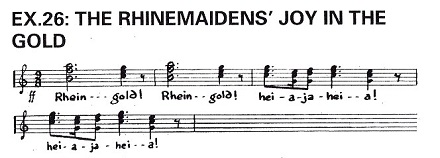
Before we trace the many transformations of this motive of the Rhinemaidens' Joy in the Gold, we should notice that it will recur several times in something like this original form. Near the end of Rheingold, it's harmonically modified and melodically developed to form Rhinemaidens' Lament for the Gold after it has been stolen from them.
《ラインの乙女の黄金の喜び》のさまざまな変形を追いかける前に、このモティーフがほぼオリジナルの形で何回か現れることに注意しましょう。『ラインの黄金』の終わり近く、このモティーフは和声を変え、メロディーを変化させて、黄金が盗まれたことを嘆く《ラインの乙女の嘆き》になります(引用注:『ラインの黄金』第4場の最終場面)。
| EX.27: 《ラインの乙女の嘆き》 |
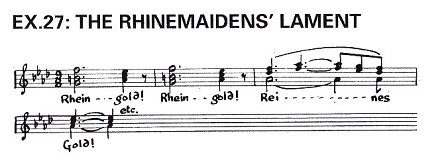
In this version, the motive recurs again several times. In Act 2 of Siegfried for example, it enters on the horns when Siegfried comes out of Fafner's cave, holding the Ring and staring at it wondering what use can be to him. The horns remind us that it belongs ultimately to Rhinemaidens. We pick up the music at Alberich's final remark and exit.
この形のモティーフは何回か再現します。例えば『ジークフリート』の第2幕において、ジークフリートが指環を持ってファフナーの洞窟から出て来るとき、ホルンに現れます。ジークフリートは指環を見つめ、それをどう使おうかと思案しています。このホルンは、指環が最終的にラインの乙女に帰属することを思い起こさせます。アルベリヒの最後のせりふから退場までの音楽を取り上げてみます(訳注:第2幕 第3場。EX.23 の直前)。
| EX.28: 『ジークフリート』における 《ラインの乙女の嘆き》 |
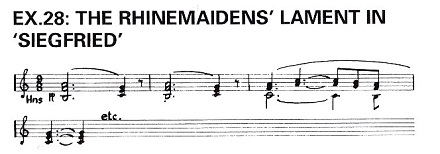
These are simple recurrences of the basic motive of the Rhinemaidens' Joy in the Gold, but the two main segments of the motive continually transformed into new motives, representing the unhappy results of the realization of the Gold's potentialities. We may start with the second of these segments, the cry of "Heiajaheia!".
これらは、基本モティーフである《ラインの乙女の黄金の喜び》のシンプルな再現でした。しかし、このモティーフの2つの主要なセグメントは絶えず変形され、新しいモティーフになります。それは黄金の潜在力の不幸な実現を表します。まず第2のセグメントである「ハイアヤ・ハイア!」の叫びからみてみましょう。
| EX.29: 《ハイアヤ・ハイア》 |

In Scene 2 of Rheingold, Loge sings a dark minor version of this when he describes how the Rhinemaidens complained to him of Alberich's theft of the Gold.
『ラインの黄金』の第2場において、ローゲはこのモティーフを暗い短調の形で歌います。ラインの乙女がアルベリヒに黄金を盗まれたことを訴えた様子を、ローゲが説明するシーンです。
| EX.30: 《ハイアヤ・ハイア》 ローゲ版 |
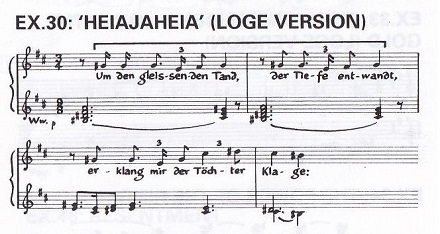
This already begins to sound a little like the Nibelungs' motive in the next Scene. And Loge takes the transformation a step further when he repeats the music we've just heard to describe how the Nibelungs are already working on the Gold.
これは既に、次の場における《ニーベルング族》のモティーフに似た響きがします。そしてローゲが今聴いたモティーフを繰り返すとき、変形をさらに進めて、ニーベルング族が既に黄金に関した仕事をしていることを説明します。
| EX.31: 《ハイアヤ・ハイア》が 《ニーベルング族》に変化 |
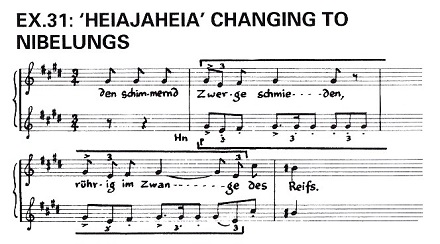
Loge's embryonic version of the Nibelungs motive becomes reality in the orchestral interlude leading to the next Scene. Here the actual motive of Nibelungs emerges in the definitive form in conjunction with the sound of their hammering.
ローゲによる《ニーベルング族》の萌芽形は、次の場に続くオーケストラの間奏曲で具現化します。ここで実際に《ニーベルング族》のモティーフは確定形へと発展します。ニーベルング族のハンマーの音が一緒になっています。
| EX.32: 《ニーベルング族》 |

So the Rhinemaidens' Joy in the potentiality of the Gold has been transformed into the Nibelungs' misery in working on the Gold, musically as well as dramatically.
And the complete basic motive of the Rhinemaidens' Joy in the Gold is transformed in a similar way to produce another new motive. Again, Loge is the agent of this tranformation in Scene 2 of Rheingold. His dark, minor version of the Heiajaheia segment, in his account of the Rhinemaidens' complaint, is actually acompanied by the complete motive of the Rhinemaidens' Joy in the Gold. Here's a reminder of that motive.
このように、ラインの乙女が黄金の潜在力を喜ぶモティーフは、黄金を加工するニーベルング族の苦難へと変形しました。音楽的にも、ドラマとしてもです。
さらに同様にして《ラインの乙女の黄金の喜び》という基本モティーフは別のモティーフに変形されます。『ラインの黄金』の第2場でローゲが再びこの変形を担当します。ローゲ版《ハイアヤ・ハイア》のセグメントは、ライン乙女の訴えを反映した暗い短調ですが、実際は《ラインの乙女の黄金の喜び》のモティーフの完全な形を伴っています。次はその基本モティーフのリマインドです。
さらに同様にして《ラインの乙女の黄金の喜び》という基本モティーフは別のモティーフに変形されます。『ラインの黄金』の第2場でローゲが再びこの変形を担当します。ローゲ版《ハイアヤ・ハイア》のセグメントは、ライン乙女の訴えを反映した暗い短調ですが、実際は《ラインの乙女の黄金の喜び》のモティーフの完全な形を伴っています。次はその基本モティーフのリマインドです。
| 《ラインの乙女の黄金の喜び》: EX.26 |

And here, played by the orchestra alone, is the accompaniment to Loge's account of the complaint of the Rhinemaidens.
そして次がオーケストラだけの演奏による、ラインの乙女の訴えを語るローゲの伴奏です。
| EX.33: 《ラインの乙女の黄金の喜び》 ローゲ版 |

This minor version of the Rhinemaidens' Joy in the Gold is further slowed down and transformed harmonically to produce the baleful motive of the Power of the Ring. This enters in Scene 3 and 4 of Rheingold when Alberich uses the Ring to compel Niebelungs to do his will.
この《ラインの乙女の黄金の喜び》の短調の形は、さらにゆっくりになり、和声が変形されて、不吉な《指環の力》のモティーフになります。これは『ラインの黄金』の第3場と第4場において、アルベリヒがニーベルング族に彼の意志を強要するために指環を使うときに出てきます。
| EX.34は、第3場においてアルベリヒがミーメを鞭打って脅す場面の金管パート。なお《指輪の力》の初出は第1場のヴェルグンデの歌唱。 |
| EX.34: 《指環の力》 |
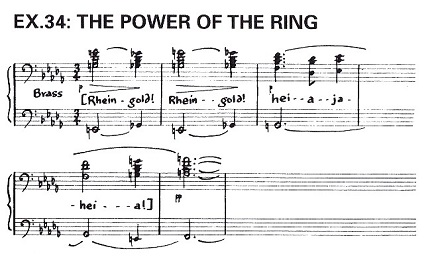
Here, the Rhinemaidens' Joy in the Gold has become Alberich's sadistic pleasure in wielding all powerful Ring he has made from the Gold.
One further motive is generated by the basic motive of the Rhinemaidens' Joy in the Gold and this too is associated with the unhappy results of the exploitation of the Gold. Here the starting point is the first segments of the motive, the cry of "Rheingold !" which we'll hear again as a reminder.
ここに至って《ラインの乙女の黄金の喜び》のモティーフは、黄金で作られた全能の "指環" を振りかざすアルベリヒのサディスティックな喜びへと変化してしまいました。
《ラインの乙女の黄金の喜び》という基本モティーフから作り出されるもう一つのモティーフも、黄金の利己的利用の不幸な結果に関係しています。出発点は《ラインの乙女の黄金の喜び》の最初のセグメントである "ラインの黄金!" という叫びです。リマインドとして再度聴いてみましょう。
《ラインの乙女の黄金の喜び》という基本モティーフから作り出されるもう一つのモティーフも、黄金の利己的利用の不幸な結果に関係しています。出発点は《ラインの乙女の黄金の喜び》の最初のセグメントである "ラインの黄金!" という叫びです。リマインドとして再度聴いてみましょう。
| 次の譜例は《ラインの乙女の黄金の喜び》(EX.26)と全く同じであるが、前半の2小節が《ラインの黄金》(EX.35)である。 |
| EX.35: 《ラインの黄金》 |

A dark minor key version of this repeated phrase is associated with the Servitude of the Niebelungs in Scene 3 of Rheingold.
この繰り返されるフレーズを暗い短調にした形は『ラインの黄金』第3場でニーベルング族の《苦役》に関係づけられます。
| EX.36: 《苦役》 |

This time, the Rhinemaidens' joy in the potentiality of the Gold has become the Niebelungs' enslavement to the Ring that has been made from the Gold. Later, this Servitude motive settles down to more limping form, particularly associated with Mime in Act 1 of Siegfried.
今度は、ラインの乙女が黄金の潜在力を喜ぶモティーフが、黄金から作られた指環に隷属するニーベルング族の表現になりました。この《苦役》はのちに、もっとびっこをひくような形になり、特に『ジークフリート』の第1幕でミーメに関連づけられます(訳注:第1場)。
| EX.37: 《苦役》 ミーメ版 |

In Gotterdammerung, this Servitude motive attaches itself to Hagen who is himself enslaved to the power of the Ring through his desire to get possession of it. Here the motive takes the form of his fierce rallying call to the vassals in Act 2 of Gotterdammerung.
『神々の黄昏』において《苦役》のモティーフはハーゲンに割り当てられます。ハーゲンは指環を所有したいという欲望によって、指環の力の奴隷になっているからです。『神々の黄昏』の第2幕でハーゲンが家臣を集めて激しく呼びかけるときの形が次です(訳注:第3場)。
| EX.38: 《ハイホー》 |

Here we come to the end of the dark family of motives generated by the bright basic motive of the Rhinemaidens' Joy in the Gold.
明るい基本モティーフである《ラインの乙女の黄金の喜び》から生成された暗いモティーフのファミリーは、これで終わりです。
ライトモティーフ譜例一覧(1)
|
| 人物・モノ・出来事・感情 |
| 《 | フンディング》 | |||
| 《 | 金の林檎》 | |||
| 《 | アルベリヒの威嚇》 | |||
| 《 | ジークフリートの怒り》 |
| 自然 |
| 《 | 自然》のモティーフ(原形) | |||
| 《 | 自然》のモティーフ(確定形) | |||
| 《 | ライン河》 | |||
| 《 | エルダ》 | |||
| 《 | エルダ》/《神々の黄昏》 | |||
| 《 | エルダ》/《神々の黄昏》 | |||
| 『 | 神々の黄昏』の《神々の黄昏》 | |||
| 《 | 世界のトネリコの樹》 | |||
| 『 | 神々の黄昏』の《世界のトネリコの樹》 | |||
| 《 | 森の囁き》萌芽形 | |||
| 《 | 森の囁き》中間形 | |||
| 《 | 森の囁き》確定形 | |||
| 《 | 黄金》 | |||
| 《 | ドンナー》 | |||
| 《 | 虹の橋》 | |||
| 『 | 神々の黄昏』における《自然》の原形 | |||
| 《 | 剣》 | |||
| 《 | ラインの乙女》 | |||
| 《 | 森の小鳥》 | |||
| 《 | 森の小鳥》のセグメント | |||
| 《 | 眠るブリュンヒルデ》 |
| 黄金 |
| 《 | ラインの乙女の黄金の喜び》 | |||
| 《 | ラインの乙女の嘆き》 | |||
| 『 | ジークフリート』における《ラインの乙女の嘆き》 | |||
| 《 | ハイアヤ・ハイア》 | |||
| 《 | ハイアヤ・ハイア》ローゲ版 | |||
| 《 | ハイアヤ・ハイア》が《ニーベルング族》に変化 | |||
| 《 | ニーベルング族》 | |||
| 《 | ラインの乙女の黄金の喜び》ローゲ版 | |||
| 《 | 指環の力》 | |||
| 《 | ラインの黄金》 | |||
| 《 | 苦役》 | |||
| 《 | 苦役》ミーメ版 | |||
| 《 | ハイホー》 |
2019-04-26 17:27
nice!(2)



